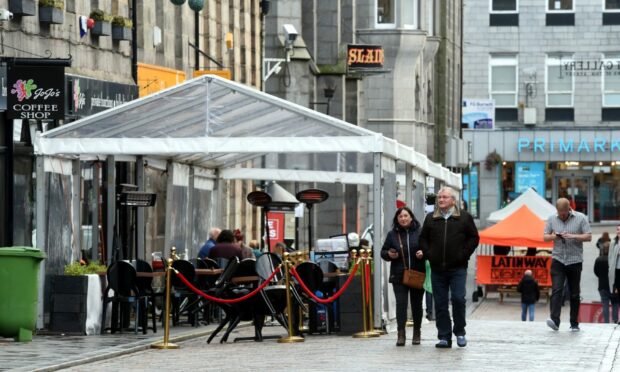Town House chiefs have marked out a way forward for plans to encourage cafe culture in Aberdeen – with a £1.5 million overhaul of a prominent city centre street.
Roads access to Belmont Street, Little Belmont Street, Back Wynd and Gaelic Lane could be overhauled, along with a shake-up of planning and licensing rules.
It comes as the area remains in flux, as the council decides how best to move out of the pandemic.
Major city centre roads were closed or changed in the immediate response to Covid-19.
And while short-term flexibility allowing food and drinks venues to take to the streets with tables and marquees has ended, the roads disruption remains.
If approved next week, council bosses say the refresh of the area – hoped to bring visitors back to the city centre – could be completed by the end of September.
Belmont Street Quarter: The proposed way ahead
City officials have brought forward six options for the so-called Belmont Street Quarter, with varying levels of council involvement in running the area.
The cheapest option would be to only remove the physical distancing roads changes put in place over the summer of 2020, at a cost of around £60,000.
But in a detailed briefing on the plans, they recommended councillors establish the local authority as the lead to ensure control and a level of uniformity in the planned expansion of outdoor dining.
The partnership, estimated to cost £1,545,200, would allow the council to be in charge of design and gaining planning approval, divvying up space for businesses and supplying partitioning and planters.
Businesses would be able to stamp their own mark on the cafe scene with their own furniture, and would be expected to secure alcohol licences and annual cafe permits.
Applications from venues in the district would be “positively received” by planning and licensing authorities.
Without this flexibility, with the local authority supplying everything fully furnished, the cost to the public purse would jump to £2.3m.
Other options include bringing a private firm in to supply the infrastructure, though that would increase costs even further.
Roads overhaul could limit delivery access to specific times of day
The plans could require increased traffic controls in the quarter, including timing restrictions for deliveries and blue badge parking and taxi ranks being moved.
The proposed way forward includes limiting Back Wynd and Gaelic Lane to local access only, while only emergency vehicles will be allowed onto Little Belmont Street.
However, at as yet undetermined times of day, a loop for service vehicles would also allow access to Back Wynd, Gaelic Lane, the southern end of Belmont Street and either end of Little Belmont Street.
Cafe culture key to majority of Belmont Street businesses plans
Resources director Steve Whyte claims two-thirds of businesses within the zone consider outdoor trading to be key to their future.
But, only nine answered the question during a recent survey.
Meanwhile, around a third – 11 of 31 respondents – expressed an interest in being involved.
Mr Whyte said the council-led partnership, the third option put to councillors, enjoyed broad support from residents in the 71 homes in the demarked area.
Assessing the suggested ways forward, he told councillors: “Option three offers the greatest degree of flexibility for businesses, allowing them to style their furnishings to suit their own preferences and those of their customers.
“It scores highly on affordability – although it is more expensive than the restoration to pre-pandemic state and laissez-faire options, it is cheaper than the fully furnished options.
“Option three also scores well for achievability as it is not dependent on an external delivery partner and therefore reduces the risk to the council.”
What now for the Belmont Street Quarter plans
Councillors are being asked to approve the business case for the Belmont Street Quarter, which would allow officials to move forward with detailed planning.
It would also kickstart in-depth talks with businesses, residents and stakeholders, such as the Disability Equity Partnership, on how the roads overhaul can best work for everyone.
Having previously been accused of “engineering” disabled people out of the city centre with the ongoing closure of Union Street Central, two interim measures are to be brought in “at the earliest opportunity”.
Following talks with the Disability Equity Partnership, accessible parking will be trialled in Back Wynd.
